《儿科学》课程教学课件(PPT讲稿)24 Mumps(Epidemic parotitis)
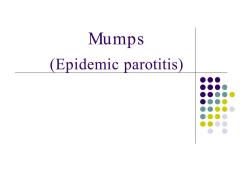
Mumps(Epidemic parotitis)
Mumps (Epidemic parotitis)
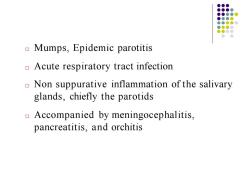
Mumps, Epidemic parotitis Acute respiratory tract infection Non suppurative inflammation of the salivaryglands, chiefly the parotids Accompanied by meningocephalitis,pancreatitis, and orchitis
□ Mumps, Epidemic parotitis □ Acute respiratory tract infection □ Non suppurative inflammation of the salivary glands, chiefly the parotids □ Accompanied by meningocephalitis, pancreatitis, and orchitis
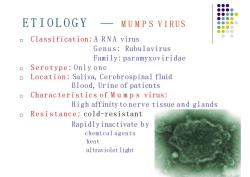
ETIOLOGYMUMPSVIRUSClassification:A RNA virus1Genus:RubulavirusFamily:paramyxoviridaeSerotype: Only one0Location: Saliva, Cerebrospinal fluid口Blood, Urine of patientsCharacteristics of Mump s virus:口High affinitytonerve tissue and glandsResistance: cold-resistant7Rapidlyinactivatebychemicalagentsheatultravioletlight
ETIOLOGY □ Classification: A RNA virus Genus: Rubulavirus Family: paramyxoviridae □ Serotype: Only one □ Location: Saliva, Cerebrospinal fluid Blood, Urine of patients □ Characteristics of Mumps virus: High affinity to nerve tissue and glands □ Resistance: cold-resistant Rapidly inactivate by chemical agents heat ultraviolet light MUMPS V I R U S
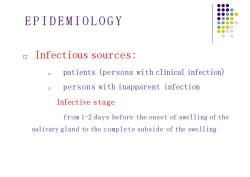
EPIDEMIOLOGYInfectious sources:patients(persons withclinical infection)口persons with inapparent infectionDInfective stagefroml-2days before theonset of swellingofthesalivarygland to the complete subside of the swelling
□ Infectious sources: □ patients (persons with clinical infection) □ persons with inapparent infection Infective stage from 1-2 days before the onset of swelling of the salivary gland to the complete subside of the swelling EPIDEMIOLOGY
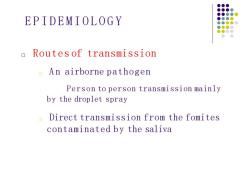
EPIDEMIOLOGYRoutesof transmissionAn airborne pathogenPerson toperson transmission mainlyby the droplet sprayDirect transmission from the fomitescontaminated by the saliva
□ Routes of transmission □ A n airborne pathogen Person to person transmission mainly by the droplet spray □ Direct transmission from the fomites contaminated by the saliva EPIDEMIOLOGY
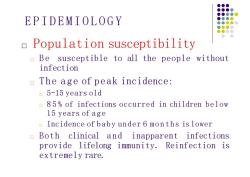
EPIDEMIOLOGY Population susceptibilityBe susceptible to all the people withoutinfectionThe age of peak incidence:1 5-15yearsold85% of infections occurred inchildren below15 years of ageIncidenceofbabyunder6monthsislowerBoth clinical and inapparent infectionsprovide lifelong immunity. Reinfection isextremely rare
□ Population susceptibility □ B e susceptible to all the people without infection □ The age of peak incidence: □ 5-15 years old □ 85% of infections occurred in children below 15 years of age □ Incidence of baby under 6 m o n ths is lower □ Both clinical a nd inapparent infections provide lifelong immunity. Reinfection is extremely rare. EPIDEMIOLOGY
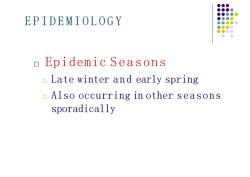
EPIDEMIOLOGY Epidemic Seasons Late winter and early springAlso occurringinother seasonssporadically
EPIDEMIOLOGY □ Epidemic S e a s ons □ Late winter and early spring □ Also occurring in other seasons sporadically
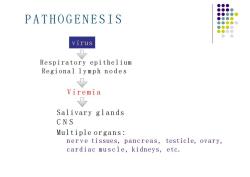
PATHOGENESISvirusRespiratoryepitheliumRegional lymph nodesViremiaSalivary glandsCNSMultiple organs:nerve tissues, pancreas, testicle, ovary,cardiac muscle,kidneys, etc
PATHOGENESIS virus Respiratory epithelium Regional lymph nodes Viremia Salivary g l a n ds CNS Multiple organs: nerve tissues, pancreas, testicle, ovary, cardiac muscle, kidneys, etc

PATHOLOGYParotidNonsuppurative inflammationDiffuseinterstitial e demaPunctiformhemorrhageSerofibrinous exudate with infiltrationoflymphocytesandmacrophagesStensen's ducts are obstructed图The glandularand ductalepitheliumundergoesdegenerative changes with intraluminalaccumulation of lymphocytes and debris.a)Amylase levelincreasedinserumandurineb)Painwithacidfoods
PA TH O LO G Y □ Parotid □ Nonsuppurative inflammation □ Diffuse interstitial edema □ Punctiform hemorrhage □ Serofibrinous exudate with infiltrationof lymphocytes and macrophages □ Stensen's ducts are obstructed □ The glandular and ductal epithelium undergoes degenerative changes with intraluminal accumulation of lymphocytes and debris. a) Amylase level increased in serum and urine b) Pain with acid foods
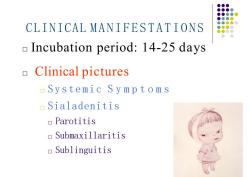
CLINICALMANIFESTATIONS Incubation period: 14-25 daysClinical picturesSystemicSymptomsSialadenitis Parotitis Submaxillaritis Sublinguitis
CLINICAL MANIFESTATIONS □ Incubation period: 14-25 days □ Clinical pictures □ Systemic Symptoms □ Sialadenitis □ Parotitis □ Submaxillaritis □ Sublinguitis
按次数下载不扣除下载券;
注册用户24小时内重复下载只扣除一次;
顺序:VIP每日次数-->可用次数-->下载券;
- 《儿科学》课程教学课件(PPT讲稿)25 Scarlet Fever.pptx
- 《儿科学》课程教学课件(PPT讲稿)26 Rotavirus Infection in Children.pptx
- 《儿科学》课程教学课件(PPT讲稿)27 Inflammation Causes Cholesterol Redistribution by Diverting Cholesterol from Circulation to Tissue Tompartments.pptx
- 《儿科学》课程教学课件(PPT讲稿)20 Toxic Bacillary Dysentery.pptx
- 《儿科学》课程教学课件(PPT讲稿)21 Chronic Gastritis in Children.pptx
- 《儿科学》课程教学课件(PPT讲稿)06 新生儿败血症 Neonatal Septicemia.pptx
- 《儿科学》课程教学课件(PPT讲稿)07 新生儿缺氧缺血性脑病 Hypoxic-ischemic Encephalopathy(HIE).pptx
- 《儿科学》课程作业习题(试卷和答案)双语试卷A卷(答案).doc
- 《儿科学》课程作业习题(试卷和答案)双语试卷A卷(试题).doc
- 《儿科学》课程作业习题(试卷和答案)双语试卷C卷(答案).doc
- 《儿科学》课程作业习题(试卷和答案)双语试卷B卷(答案).doc
- 《儿科学》课程作业习题(试卷和答案)双语试卷B卷(试题).doc
- 《儿科学》课程作业习题(试卷和答案)双语试卷C卷(试题).doc
- 《儿科学》课程作业习题(典型病例)02 pneumonia.doc
- 《儿科学》课程作业习题(典型病例)01 ABO incompatibility of neonates.doc
- 《儿科学》课程作业习题(典型病例)03 congenital heart disease-TOF.doc
- 《儿科学》课程作业习题(典型病例)07 congenital hypothyroidism.doc
- 《儿科学》课程作业习题(典型病例)05 purulent meningitis.doc
- 《儿科学》课程作业习题(典型病例)04 iron deficiency anemia.doc
- 《儿科学》课程作业习题(典型病例)03 congenital heart disease-VSD.doc
- 《儿科学》课程教学课件(PPT讲稿)23 Infantile Hepatitis Syndrome.pptx
- 《儿科学》课程教学课件(PPT讲稿)22 Infantale Diarrhea and Fluid Therapy.pptx
- 《儿科学》课程教学课件(PPT讲稿)19 Pediatric Tuberculosis.pptx
- 《儿科学》课程教学课件(PPT讲稿)18 Varicella.pptx
- 《儿科学》课程教学课件(PPT讲稿)17 Measles.pptx
- 《儿科学》课程教学课件(PPT讲稿)16 Growth Hormone Deficiency.pptx
- 《儿科学》课程教学课件(PPT讲稿)15 Congenital Hypothyroidism.pptx
- 《儿科学》课程教学课件(PPT讲稿)14 Immunodeficiency.pptx
- 《儿科学》课程教学课件(PPT讲稿)13 Acute Glomerulonephritis,Nephrotic Syndrome.pptx
- 《儿科学》课程教学课件(PPT讲稿)12 Acute Convulsion in Children.pptx
- 《儿科学》课程教学课件(PPT讲稿)11 Nutritional Iron Deficiency Anemia.pptx
- 《儿科学》课程教学课件(PPT讲稿)10 Haematopoiesis and Blood Cell Counts.pptx
- 《儿科学》课程教学课件(PPT讲稿)09 Congenital Heart Disease.pptx
- 《儿科学》课程教学课件(PPT讲稿)08 Respiratory Disorders.pptx
- 《儿科学》课程教学课件(PPT讲稿)05 Neonatal Jaundice,Hemolytic Disease of Newborn.pptx
- 《儿科学》课程教学课件(PPT讲稿)04 Nutrition During Childhood.pptx
- 《儿科学》课程教学课件(PPT讲稿)03 Development.pptx
- 《儿科学》课程教学课件(PPT讲稿)02 Growth.pptx
- 《儿科学》课程教学课件(PPT讲稿)01 Introduction of Pediatrics.pptx
- 重庆医科大学:《妇产科学》课程教学大纲 A Teaching Outline for Obstetrics and Gynecology Course(中英文双语).pdf
